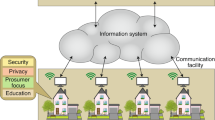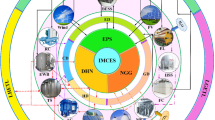Abstract
Peer-to-peer (P2P) exchange of renewable energy is an attractive option to empower citizens to actively participate in the energy transition. Whereas previous research has assessed P2P communities primarily from a techno-economic perspective, little is yet known about prosumer preferences for solar power trading. Importantly, impacts of community members’ trading decisions on key performance indicators, such as individual electricity bills, community autarky and grid stress, remain unknown. Here, we assess P2P trading decisions of German homeowners on the basis of an online experimental study, and simulate how various decision-making strategies impact the performance of P2P communities. The findings suggest that community autarky is slightly higher when prosumers are enabled to trade energy compared to when they merely aim to maximize their self-consumption. Our analysis, moreover, shows that P2P energy trading based on human decision-making may lead to financial benefits for prosumers and traditional consumers, and reduced stress for the grid.
This is a preview of subscription content, access via your institution
Access options
Access Nature and 54 other Nature Portfolio journals
Get Nature+, our best-value online-access subscription
$29.99 / 30 days
cancel any time
Subscribe to this journal
Receive 12 digital issues and online access to articles
$119.00 per year
only $9.92 per issue
Buy this article
- Purchase on Springer Link
- Instant access to full article PDF
Prices may be subject to local taxes which are calculated during checkout



Similar content being viewed by others
Data availability
All the raw data, including the online study, and the data required to create each figure, are available at https://doi.org/10.5281/zenodo.5571499. The electricity consumption data from Germany are available at http://pvspeicher.htw-berlin.de
Code availability
All the code that supports the findings of this study, and the code used to generate the figures is available in https://github.com/alefunxo/P2P-communities-PV-Battery. Python (v.3.7.2) and R (v.3.6.3) were used for data analysis and simulation, including the following packages: pandas (v.0.24.2), numpy (v.1.16.1), seaborn (v.0.7.1), matplotlib (v.3.0.2), prosumpy (unique version), ggplot2 (v.3.3.3), ggpubr (v.0.4.0), grid (base), gridExtra (v.2.3), reshape2 (v.1.4.3), dplyr (.1.0.2).
References
European Union. Directive (EU) 2018/2001 of the European parliament and of the council of 11 December 2018 on the promotion of the use of energy from renewable sources. Off. J. Eur. Union 5, 82–209 (2018).
Carlisle, N., Elling, J. & Penney, T. Renewable Energy Community: Key Elements Technical Report No. NREL/TP-540-42774 (National Renewable Energy Laboratory, 2008).
Council of European Energy Regulators. Regulatory Aspects of Self-consumption and Energy Communities Technical Report (Council of European Energy Regulators, 2019).
Savelli, I. & Morstyn, T. Better together: harnessing social relationships in smart energy communities. Energy Res. Soc. Sci. 78, 102125 (2021).
Devine-Wright, P. Community versus local energy in a context of climate emergency. Nat. Energy 4, 894–896 (2019).
Koirala, B. P., Koliou, E., Friege, J., Hakvoort, R. A. & Herder, P. M. Energetic communities for community energy: a review of key issues and trends shaping integrated community energy systems. Renew. Sustain. Energy Rev. 56, 722–744 (2016).
Parra, D. et al. An interdisciplinary review of energy storage for communities: challenges and perspectives. Renew. Sustain. Energy Rev. 79, 730–749 (2017).
Ableitner, L. et al. User behavior in a real-world peer-to-peer electricity market. Appl. Energy 270, 115061 (2020).
Parag, Y. & Sovacool, B. K. Electricity market design for the prosumer era. Nat. Energy 1, 16032 (2016).
Hahnel, U. J., Herberz, M., Pena-Bello, A., Parra, D. & Brosch, T. Becoming prosumer: revealing trading preferences and decision-making strategies in peer-to-peer energy communities. Energy Policy 137, 111098 (2020).
Lüth, A., Zepter, J. M., del Granado, P. C. & Egging, R. Local electricity market designs for peer-to-peer trading: the role of battery flexibility. Appl. Energy 229, 1233–1243 (2018).
Wilkinson, S., Hojckova, K., Eon, C., Morrison, G. M. & Sandén, B. Is peer-to-peer electricity trading empowering users? Evidence on motivations and roles in a prosumer business model trial in Australia. Energy Res. Soc. Sci. 66, 101500 (2020).
Dudjak, V. et al. Impact of local energy markets integration in power systems layer: a comprehensive review. Appl. Energy 301, 117434 (2021).
Hackbarth, A. & Löbbe, S. Attitudes, preferences, and intentions of German households concerning participation in peer-to-peer electricity trading. Energy Policy 138, 111238 (2020).
Reuter, E. & Loock, M. Empowering Local Electricity Markets: a Survey Study from Switzerland, Norway, Spain and Germany. Empower 2020 (Institute for Economy and the Environment, 2017).
Fell, M. J., Schneiders, A. & Shipworth, D. Consumer demand for blockchain-enabled peer-to-peer electricity trading in the united kingdom: an online survey experiment. Energies 12, 3913 (2019).
Ecker, F., Spada, H. & Hahnel, U. J. Independence without control: autarky outperforms autonomy benefits in the adoption of private energy storage systems. Energy Policy 122, 214–228 (2018).
Andoni, M. et al. Blockchain technology in the energy sector: a systematic review of challenges and opportunities. Renew. Sustain. Energy Rev. 100, 143–174 (2019).
Wörner, A. et al. Trading solar energy within the neighborhood: field implementation of a blockchain-based electricity market. Energy Inform. 2, 11 (2019).
Liu, N. et al. Energy-sharing model with price-based demand response for microgrids of peer-to-peer prosumers. IEEE Trans. Power Syst. 32, 3569–3583 (2017).
Zhou, Y., Wu, J. & Long, C. Evaluation of peer-to-peer energy sharing mechanisms based on a multiagent simulation framework. Appl. Energy 222, 993–1022 (2018).
Hutty, T. D. et al. Peer-to-peer electricity trading as an enabler of increased PV and EV ownership. Energy Convers. Manag. 245, 114634 (2021).
Gigerenzer, G. & Gaissmaier, W. Heuristic decision making. Annu. Rev. Psychol. 62, 451–482 (2011).
Simon, H. A. A behavioral model of rational choice. Q. J. Econ. 69, 99–118 (1955).
Hahnel, U. J., Chatelain, G., Conte, B., Piana, V. & Brosch, T. Mental accounting mechanisms in energy decision-making and behaviour. Nat. Energy 5, 952–958 (2020).
Ahl, A., Yarime, M., Tanaka, K. & Sagawa, D. Review of blockchain-based distributed energy: implications for institutional development. Renew. Sustain. Energy Rev. 107, 200–211 (2019).
Sivaraman, P. & Sharmeela, C. in Power Quality in Modern Power Systems (eds Sanjeevikumar, P. et al.) 61–103 (Academic Press, 2021).
Tjaden, T., Bergner, J., Weniger, J. & Quaschning, V. Repräsentative elektrische Lastprofile für Wohngebäude in Deutschland auf 1-sekündiger Datenbasis (Hochschule für Technik und Wirtschaft HTW, 2015).
Kosowatz, J. Energy storage smooths the duck curve. Mech. Eng. 140, 30–35 (2018).
Gupta, R. et al. Spatial analysis of distribution grid capacity and costs to enable massive deployment of PV, electric mobility and electric heating. Appl. Energy 287, 116504 (2021).
Heptonstall, P. J. & Gross, R. J. A systematic review of the costs and impacts of integrating variable renewables into power grids. Nat. Energy 6, 72–83 (2021).
Hartvigsson, E., Odenberger, M., Chen, P. & Nyholm, E. Estimating national and local low-voltage grid capacity for residential solar photovoltaic in Sweden, UK and Germany. Renew. Energy 171, 915–926 (2021).
Hartvigsson, E., Odenberger, M., Chen, P. & Nyholm, E. Generating low-voltage grid proxies in order to estimate grid capacity for residential end-use technologies: the case of residential solar PV. MethodsX 8, 101431 (2021).
Jenkins, K., McCauley, D., Heffron, R., Stephan, H. & Rehner, R. Energy justice: a conceptual review. Energy Res. Soc. Sci. 11, 174–182 (2016).
Morstyn, T., Savelli, I. & Hepburn, C. Multiscale design for system-wide peer-to-peer energy trading. One Earth 4, 629–638 (2021).
Carley, S. & Konisky, D. M. The justice and equity implications of the clean energy transition. Nat. Energy 5, 569–577 (2020).
Attari, S. Z. Transforming energy use. Curr. Opin. Behav. Sci. 42, 104–108 (2021).
Marghetis, T., Attari, S. Z. & Landy, D. Simple interventions can correct misperceptions of home energy use. Nat. Energy 4, 874–881 (2019).
Plewnia, F. & Guenther, E. The transition value of business models for a sustainable energy system: the case of virtual peer-to-peer energy communities. Organ. Environ. 34, 479–503 (2021).
Ransan-Cooper, H., Sturmberg, B. C., Shaw, M. E. & Blackhall, L. Applying responsible algorithm design to neighbourhood-scale batteries in Australia. Nat. Energy 6, 815–823 (2021).
Ruf, H. Limitations for the feed-in power of residential photovoltaic systems in Germany—an overview of the regulatory framework. Sol. Energy 159, 588–600 (2018).
Quoilin, S., Kavvadias, K., Mercier, A., Pappone, I. & Zucker, A. Quantifying self-consumption linked to solar home battery systems: statistical analysis and economic assessment. Appl. Energy 182, 58–67 (2016).
Eurostat. Household energy prices in the EU increased compared with 2018. Eurostat News Release (7 May 2020).
Beitollahi, H. & Deconinck, G. Peer-to-peer networks applied to power grid. In Proc. International Conference on Risks and Security of Internet and Systems (CRiSIS) in Conjunction with the IEEE GIIS Vols. 7 and 8 (ed. Deswarte, Y.) (LAAS-CNRS, 2007).
Innovation Landscape Brief: Peer-to-peer Electricity Trading IRENA OECD/IEA Ren21, 1–20 (International Renewable Energy Agency, 2020).
Acknowledgements
This research project was financially supported by the Swiss Innovation Agency Innosuisse and is part of the Swiss Competence Center for Heat and Electricity Storage (SCCER-HaE) with the following grant number: 1157002526 awarded to M.P. and D.P., as well as part of the activities of the Competence Center for Research in Energy, Society and Transition (CREST). This work was supported by a grant from the Swiss National Research Foundation (grant no. 188637) awarded to D.P and U.J.J.H. Additionally, funding was provided to V.T. by the Bavarian State Ministry of Science and the Arts (coordinated by the Bavarian Research Institute for Digital Transformation (BIDT)). The funding sources had no involvement in the preparation of the article, in the study design, the collection, analysis and interpretation of data, nor in the writing of the manuscript. Furthermore, we thank P. Timoner for his insights in statistical analyses and E. Hartvigsson for his insights on grid modelling.
Author information
Authors and Affiliations
Contributions
A.P.-B., D.P. and U.J.J.H. provided conceptualization of the project, carried out the investigations and wrote the original draft of the paper. A.P.-B., D.P., U.J.J.H. and V.T. designed the methodology. A.P.-B. managed the software and validation. Formal analysis was undertaken by A.P.-B., D.P., U.J.J.H. and M.H. U.J.J.H. and M.H. curated the data. M.K.P., D.P. and U.J.J.H. supervised the project and acquired funding. V.T., M.H., D.P., U.J.J.H. and M.K.P. reviewed and edited the manuscript. All authors gave their final approval for publication.
Corresponding authors
Ethics declarations
Competing interests
The authors declare no competing interests.
Additional information
Peer review information Nature Energy thanks Binod Koirala and the other, anonymous, reviewer(s) for their contribution to the peer review of this work.
Publisher’s note Springer Nature remains neutral with regard to jurisdictional claims in published maps and institutional affiliations.
Supplementary information
Supplementary Information
Supplementary Notes 1–7, Figs. 1–18 and Tables 1–8.
Rights and permissions
About this article
Cite this article
Pena-Bello, A., Parra, D., Herberz, M. et al. Integration of prosumer peer-to-peer trading decisions into energy community modelling. Nat Energy 7, 74–82 (2022). https://doi.org/10.1038/s41560-021-00950-2
Received:
Accepted:
Published:
Issue Date:
DOI: https://doi.org/10.1038/s41560-021-00950-2
This article is cited by
-
Sustainable plug-in electric vehicle integration into power systems
Nature Reviews Electrical Engineering (2024)
-
It starts at home: non-economic factors influencing consumer acceptance of battery storage in Australia
Environmental Science and Pollution Research (2024)
-
A classification scheme for local energy trading
OR Spectrum (2023)
-
Transfer learning strategies for solar power forecasting under data scarcity
Scientific Reports (2022)
-
Consumer awareness of load shapes
Nature Energy (2022)



